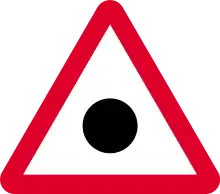Accident blackspot
In road safety management, an accident blackspot or black spot is a place where road traffic accidents have historically been concentrated. It may have occurred for a variety of reasons, such as a sharp drop or corner in a straight road, so oncoming traffic is concealed, a hidden junction on a fast road, poor or concealed warning signs at a cross-roads.

For some decades treatment of accident blackspots (e.g. by signage, speed restrictions, improving sightlines, straightening bends, or speed cameras) was a mainstay of road safety policy, but current thinking has it that the benefits of these interventions are often overstated. Effects such as regression to the mean,[1] risk compensation[2] and accident migration combine to reduce the overall benefit.
In some cases it has been claimed that the end result is an increase in overall casualties. In one notable experiment, a number of accident blackspots were "treated" with a null treatment—placement of a garden gnome, according to some reports. Accident rates at these points were found to have decreased significantly in the following period, a finding which is taken as clear evidence supporting the theory of regression to the mean.
See also
References
- Discussion of accident blackspots URL is invalid
Footnotes
- UCL and PA Consulting Group for Department for Transport UK national safety camera programme - Four-year evaluation report December 2005 Archived November 22, 2008, at the Wayback Machine Appendix H describes the effects of RTM
- Jackson JSH, Blackman R (1994). "A driving-simulator test of Wilde's risk homeostasis theory". Journal of Applied Psychology. Cite journal requires
|journal=(help)
| Look up accident blackspot in Wiktionary, the free dictionary. |
